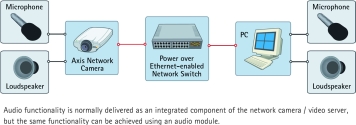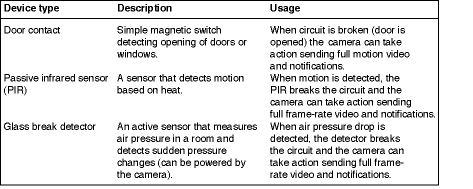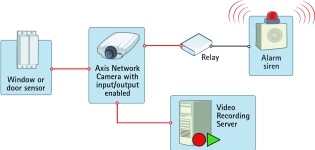
In this instalment of the series, we continue our look at video systems design looking at data bandwidth and storage control, and the different kinds of data that can be involved.
Frame rate control
Network video allows for 'frame rate control' -as opposed to analog video where 'all video is sent from the camera all the time'. Frame rate control means that the network camera/video server only sends images at a controlled frame rate: for example, camera/video server or video management software can raise the frame rate on an event such as motion detection or a contact closure.

It is also possible to send video with different frame rates to different recipients - a great benefit when using low bandwidth links to remote locations.

Video motion detection
Video motion detection (VMD) refers to detecting activity in a scene by analysing image data and differences in series of images.
In DVR (digital video recorder) systems cameras are connected to the DVR, which performs the VMD on each video stream. This allows the DVR to decrease the amount of recorded video, to prioritise recordings and to use motion in a specific area of the image as a search term when searching for events. The downside of this method is that performing VMD is a CPU intensive process, and performing VMD on many channels puts a heavy strain on the DVR system.
In network video systems VMD can be an integral function of the network cameras or video servers, offering substantial advantages. The most significant advantage is that the VMD is processed in the network camera or video server itself. This lightens the workload for the recording system and makes 'event-driven surveillance' possible. With event-driven surveillance either no video or only low frame rate video is sent to the operator or recording system unless activity is detected in the scene. VMD data with information about the activity can also be included in the video stream to simplify activity searches in recorded material. VMD can also reside in the video management software, thus providing VMD functionality to network cameras that do not originally embed this feature.
Advantages of local VMD in the 'endpoint' (network camera or video server):
* Conserves bandwidth.
* Reduces CPU load on recording server.
* Saves storage space.
* The camera can interact with other systems using I/O ports (for example triggering alarms).
Audio
Audio can easily be integrated into network video as the network can carry any type of data, which reduces the need for extra cabling - as opposed to analog systems where an audio cable must be installed from endpoint to endpoint. A network camera captures audio at the camera, merges it with the video stream, and then sends it back for monitoring and/or recording over the network. This makes it possible to use audio from remote locations. For instance, monitoring personnel at a company's headquarters can interact with 'surveillance scenes' at remote branch offices. They can inform possible perpetrators that they are under surveillance and listen in on situations using the audio as an additional confirmation method.

Audio can also be used in network cameras or video servers as an independent detection method, which triggers video recordings and alarms when audio levels above a certain threshold are detected.
Audio can be compressed and transmitted as an integrated part of the video stream, if MPEG-1/ MPEG-2/MPEG-4 or any of the H.x video conferencing standards are used. It can also be transmitted in parallel if using a still image standard, such as JPEG. However, if synchronised audio and video is prioritised, MPEG is the preferred choice. Nonetheless, there are many situations where synchronised audio is less important or even undesirable (for example if audio is to be monitored but not recorded).
Digital audio compression allows for efficient transmission and storage of audio data. As with video, there are many audio compression techniques, which offer different levels of compressed audio quality. In general, higher compression levels introduce more latency. Audio in digital form offers many advantages, for example high noise immunity, stability, and reproducibility. It also allows for efficient implementation of many audio post-processing functions, such as noise filtering and equalisation.
Popular audio compression formats include:
* G.711 PCM providing high quality audio at 64 Kbps bit rate.
* G.726 ADPCM providing audio at 32 or 24 Kbps bit rate.
* MP3 (which stands for ISO-MPEG Audio Layer-3), a popular format geared towards music, with bit rates around 100 Kbps.
Depending on your network cameras, there can be several audio modes to choose from:




Audio functionality is normally delivered as an integrated component of the network camera/video server, but the same functionality can be achieved using an audio module.

Digital inputs and outputs (I/Os)
A unique feature of network video products is their integrated digital inputs and outputs that are manageable over the network. The output can be used to trigger mechanisms either from a remote PC or automatically, using the camera's built-in logic, while inputs can be configured to respond to external sensors such as passive infrared sensors (PIRs) or pushbutton initiating video transfers. The I/Os can be used in conjunction with alarm sensors, for instance, to prevent unnecessary transfers of video, transmitting only when the sensor attached to the camera triggers.

Digital inputs
The range of devices that can be connected to a network camera's input port is almost infinite. The basic rule is that any device that can toggle between an open and closed circuit can be connected to a network camera or a video server.
Digital outputs
The main function of output ports is to allow the camera to trigger external devices, either automatically or by remote control from a human operator or a software application.

For more information contact Roy Alves, Axis Communications, +27 (0) 11 548 6780, [email protected]

© Technews Publishing (Pty) Ltd. | All Rights Reserved.